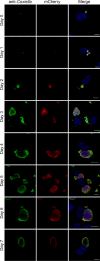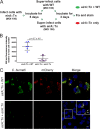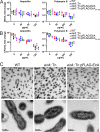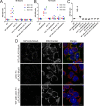EirA Is a Novel Protein Essential for Intracellular Replication of Coxiella burnetii
- PMID: 32205404
- PMCID: PMC7240097
- DOI: 10.1128/IAI.00913-19
EirA Is a Novel Protein Essential for Intracellular Replication of Coxiella burnetii
Abstract
The zoonotic bacterial pathogen Coxiella burnetii is the causative agent of Q fever, a febrile illness which can cause a serious chronic infection. C. burnetii is a unique intracellular bacterium which replicates within host lysosome-derived vacuoles. The ability of C. burnetii to replicate within this normally hostile compartment is dependent on the activity of the Dot/Icm type 4B secretion system. In a previous study, a transposon mutagenesis screen suggested that the disruption of the gene encoding the novel protein CBU2072 rendered C. burnetii incapable of intracellular replication. This protein, subsequently named EirA (
Keywords: Coxiella burnetii; bacterial pathogenesis; host-pathogen interactions; type IV secretion system; virulence factor; virulence factors.
Copyright © 2020 American Society for Microbiology.
Figures








Similar articles
-
The Coxiella burnetii Dot/Icm system creates a comfortable home through lysosomal renovation.mBio. 2011 Oct 18;2(5):e00226-11. doi: 10.1128/mBio.00226-11. Print 2011. mBio. 2011. PMID: 22010216 Free PMC article.
-
Coxiella burnetii encodes an LvgA-related protein important for intracellular replication.Cell Microbiol. 2021 Jun;23(6):e13331. doi: 10.1111/cmi.13331. Epub 2021 Apr 22. Cell Microbiol. 2021. PMID: 33774901
-
Host pathways important for Coxiella burnetii infection revealed by genome-wide RNA interference screening.mBio. 2013 Jan 29;4(1):e00606-12. doi: 10.1128/mBio.00606-12. mBio. 2013. PMID: 23362322 Free PMC article.
-
Coxiella burnetii as a useful tool to investigate bacteria-friendly host cell compartments.Int J Med Microbiol. 2018 Jan;308(1):77-83. doi: 10.1016/j.ijmm.2017.09.010. Epub 2017 Sep 14. Int J Med Microbiol. 2018. PMID: 28935173 Review.
-
Right on Q: genetics begin to unravel Coxiella burnetii host cell interactions.Future Microbiol. 2016 Jul;11(7):919-39. doi: 10.2217/fmb-2016-0044. Epub 2016 Jul 15. Future Microbiol. 2016. PMID: 27418426 Free PMC article. Review.
Cited by
-
Galleria mellonella-intracellular bacteria pathogen infection models: the ins and outs.FEMS Microbiol Rev. 2023 Mar 10;47(2):fuad011. doi: 10.1093/femsre/fuad011. FEMS Microbiol Rev. 2023. PMID: 36906279 Free PMC article. Review.
-
Coxiella co-opts the Glutathione Peroxidase 4 to protect the host cell from oxidative stress-induced cell death.Proc Natl Acad Sci U S A. 2023 Sep 5;120(36):e2308752120. doi: 10.1073/pnas.2308752120. Epub 2023 Aug 28. Proc Natl Acad Sci U S A. 2023. PMID: 37639588 Free PMC article.
-
Pathogenicity and Virulence of Coxiella burnetii: Focus on Q fever.Virulence. 2025 Dec;16(1):2495842. doi: 10.1080/21505594.2025.2495842. Epub 2025 Jun 19. Virulence. 2025. PMID: 40536474 Free PMC article. Review.
-
Macrophage infectivity potentiator protein, a peptidyl prolyl cis-trans isomerase, essential for Coxiella burnetii growth and pathogenesis.PLoS Pathog. 2023 Jul 3;19(7):e1011491. doi: 10.1371/journal.ppat.1011491. eCollection 2023 Jul. PLoS Pathog. 2023. PMID: 37399210 Free PMC article.
-
Coxiella burnetii and Related Tick Endosymbionts Evolved from Pathogenic Ancestors.Genome Biol Evol. 2021 Jul 6;13(7):evab108. doi: 10.1093/gbe/evab108. Genome Biol Evol. 2021. PMID: 34009306 Free PMC article.
References
Publication types
MeSH terms
Substances
LinkOut - more resources
Full Text Sources

